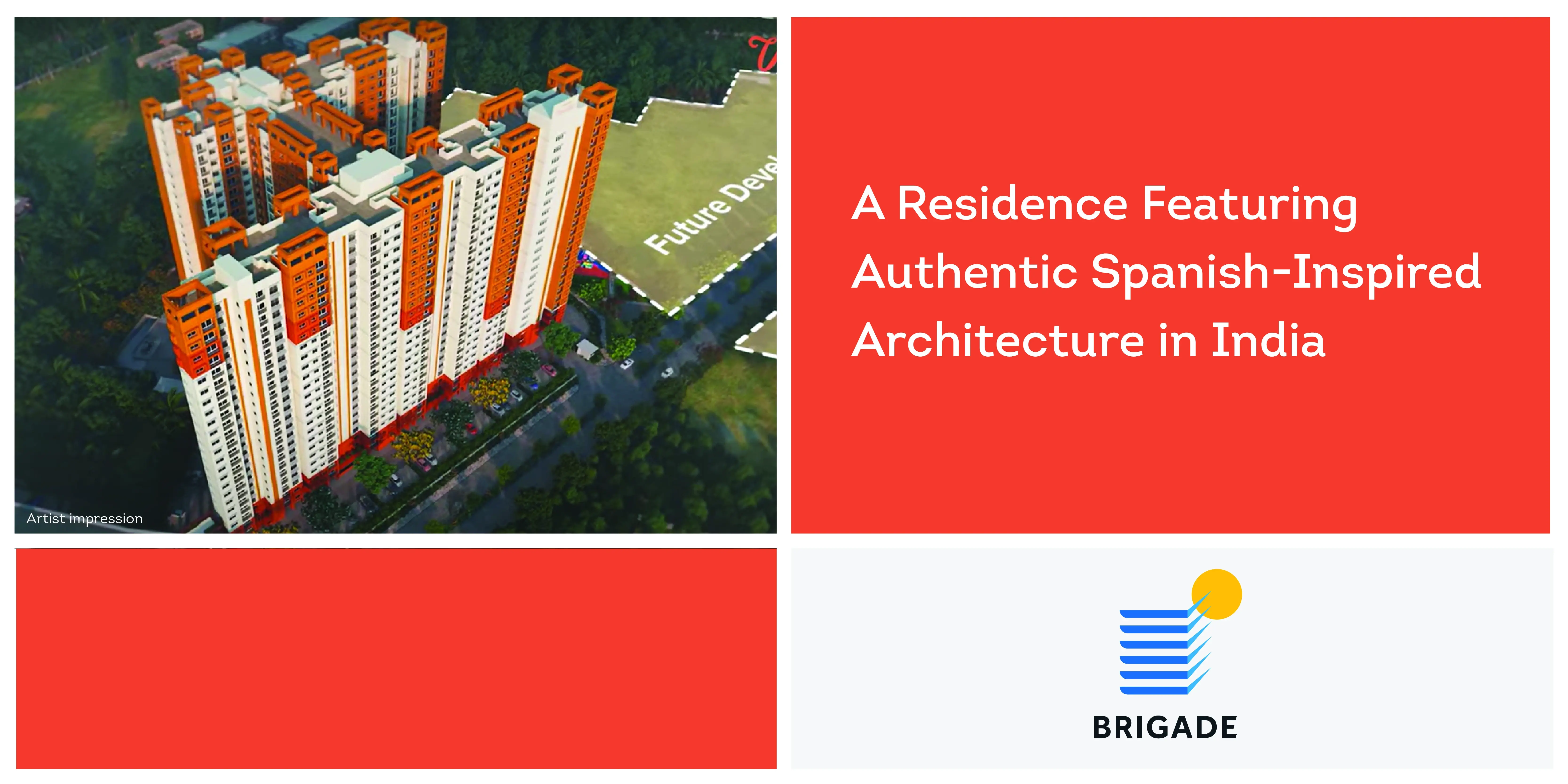


15th November 2023
A Residence Featuring Authentic Spanish-Inspired Architecture in India
When art blends with architecture, you get the perfect abode that reflects your aestheticism and uplifts your mood. A Spanish-style house is an exquisite example of this marriage that reflects taste and is utilitarian in its concept.
Since Goodhue's exhibition, features like white stucco walls and red tile roofs have become a rage in the US. Architects exhibited an enthusiastic embracement of Spanish architecture through the 50s. The exhibition popularised the style across the world.
In this blog, we will delve into Spanish-style architecture's intricacies and beauty.
What are Spanish-style Homes?
Spanish-style residences can be distinguished by their unique architectural design, muted ornamentation, sleek stucco walls and exteriors made of adobe or stone. Their distinctive features often include roofing crafted from tiles and stone, most often adorned with barrel-shaped tiles in earthy hues.
Other notable traits encompass arched doorways, entrances and windows and robust wooden doors decorated with intricate carvings and metalwork.
Contemporary homes based on a Spanish style architecture may feature an inner courtyard, possibly bordered by arcades and adorned with water features, alcoves, wrought ironwork or vibrant tile accents. Exposed wooden beams and tile, stone or cobblestone floors are also prevalent interior elements in these homes.
The Different Types of Spanish-Style Houses
Spanish-style homes have captured the hearts of homeowners and architects alike for centuries. These structures stand as testaments to Spanish-speaking regions' rich and diverse heritage worldwide. Each tells a unique story, steeped in tradition, culture and a profound appreciation for aesthetics.
Here's a peek into the different varieties of Spanish homes that define this timeless and vibrant style:
Mission Revival
Overview: The style is reminiscent of the Spanish missions in California, USA. It draws inspiration from the erstwhile architecture during Spain's colonial era in the US.
Key Features:
1. Arch-shaped doors and windows
2. Stucco exterior walls
3. Curved porch
4. Vertical structures resembling Spanish church bell towers
5. Green and expansive courtyards
6. Red-tiled roofs with a low slope
7. A quatrefoil-shaped window
8. Extended covers supported by pillars
9. Subtle decorative elements
Pueblo Revival
Overview: The Pueblo Revival style became popular between 1900 and 1940. It drew inspiration from Indian Pueblo and Spanish Colonial architectural forms.
Key Features:
1. Thick, rounded adobe or stucco walls.
2. Flat roofs with parapets.
3. Vigas (wooden beams) extend through the exterior walls.
4. Kiva fireplaces and nichos (recessed shelves).
5. Courtyards with desert landscaping.
Monterey Revival
Overview: The fusion of the New England and Spanish colonial architecture forms brewed the Monterey Revival style.
Key Features:
1. Two-storey homes with a wooden upper level and stucco lower level.
2. Double-hung and long casement windows.
3. A prominent central balcony or veranda.
4. Gabled roofs with wooden shingles or clay tiles.
5. Simple, symmetrical facades.
6. Adobes or bricks for the lower walls.
Floridian Revival
Overview: Suited for the Mediterranean climate, Spanish/Moorish architecture form influences the Floridian revival style.
Key Features:
1. Stucco exteriors with a wide range of colour options, including earthy tones.
2. Tiled roofs, sometimes with terracotta tiles.
3. Ornate balconies and terraces with balustrades.
4. Decorative tiles and mosaics.
5. Arched doorways and windows.
Spanish Eclectic
Overview: The style combines elements drawn from Spanish, African, Latin American and Native American cultures.
Key Features:
1. Diverse colour palettes for stucco exteriors.
2. S-shaped clay roof tiles that are either red or reddish brown and are slanted downwards.
3. Unique round arches over doors, porch entries and windows.
4. Distinctly patterned tiles cover walls and floors.
5. Thick stucco walls in light or earthy tones.
6. Guest house located in the back or front of the main house.
7. Creative use of wrought-iron accents.
Architectural Elements of Spanish-Style Homes
Spanish-style homes have a unique charm and elegance that transcends time and trends. Rooted in Spain's rich history and architectural influences, these homes have become a beloved architectural style in many parts of the world.
Here's a look at the features that distinguish Spanish-style homes from the rest:
Curves and Arches
Arches are a hallmark of Spanish architecture, adding a sense of grandeur and are reminiscent of the colonial era.
These arches are often accentuated with intricate wrought-iron details, adding dimensions to the home's character.
Stucco Exterior and Walls
The most iconic characteristic of a Spanish-style home is its stucco exterior. Stucco, a type of plaster, is applied to the walls to create a textured, earthy appearance. This provides insulation and gives the home a rustic, Mediterranean feel.
Typically, these exteriors are painted in warm, earthy tones like terracotta, beige, or soft white, adding to their inviting appeal.
Painted Tiles
Hand-painted tiles accentuate the overall design of Spanish-style residences. The tiles are generally fitted in the interiors of kitchens and bathrooms.
Terracotta Roof Tiles
Saltillo and Terracotta tiles are frequently used for flooring in Spanish-themed homes. These handmade clay tiles come in various earthy tones and geometric patterns, adding a rustic and authentic touch to the interior spaces. The coolness of the terracotta roof tiles makes the feature suitable for places experiencing tropical climates.
Tower-Like Chimneys
The feature gives a vertical dimension to the entire house. Spanish-style houses often feature chimneys protruding from the roof that are fully functional. The vents are beautified with small windows and mouldings.
Balconies
Expansive balconies are a signature of Spanish colonial architecture. It is designed to let people soak in the pleasant weather and get some fresh air.
Courtyards and Patios
Spanish buildings often feature courtyards and patios that serve as outdoor living spaces. These areas are designed for relaxation and entertainment, typically adorned with lush greenery, colourful tiles and a central fountain.
Courtyards and patios are integral to the lifestyle of Spaniards, encouraging outdoor gatherings and leisurely evenings.
Are Spanish-Style Homes Ideal for Hot Climates?
Spanish home architecture has earned the utilitarian label because of its adaptability to hostile weather conditions. With their distinctive features and elements, these homes have proven their functionality in regions with scorching temperatures. Here's why:
Thick adobe walls keep the indoor spaces cool by acting as a barrier to the relentless heat outside. The thermal mass of the walls absorbs heat during the day and releases it slowly at night, maintaining a comfortable and consistent temperature inside the home.
The central courtyard or patio typically features a fountain or a pool, which adds a refreshing aesthetic and helps cool the air as water evaporates. These shaded outdoor areas are perfect for enjoying the warm climate without exposing oneself to direct sunlight.
The terracotta roof tiles are made of natural materials and earthy colours that reflect sunlight, reducing the heat the roof absorbs. This reflective quality helps lower interior temperature, minimising the need for excessive air conditioning.
The layout of Spanish-style homes often includes strategically placed windows and doors that facilitate cross-ventilation. Cross-ventilation is essential for allowing fresh air flow throughout the house, helping dissipate heat and maintain a comfortable indoor environment.
Another architectural feature of Spanish-style homes that makes them perfect for hot weather is the presence of shaded arcades and balconies. These covered areas provide additional outdoor spaces that protect residents from direct sunlight.
Spanish-style homes are typically constructed using natural wood, stone and clay. Wood beams and ceilings, for example, are excellent insulators, while stone floors remain cool to the touch, offering a respite from the heat.
Why You Should Invest in Spanish Touch Homes?
Choosing the architectural style is entirely dependent on your aesthetic preference and requirements. However, here are some factors that may motivate you to invest in Spanish-style contemporary homes:
Timeless Architectural Beauty
The beauty of Spanish architecture is timeless, ensuring that your investment will remain attractive to future generations. Characterised by red clay tile roofs, stucco exteriors, arched doorways and wrought-iron details, these homes exude elegance and charm.
Historical Significance
You own a piece of history when you invest in a Spanish-style home. Originating in the early 20th century, the architecture bears anecdotes of the Spanish colonial period. Owning a Spanish-style home allows you to be part of a legacy, and such properties often hold a special place in their community's history.
Strong Resale Value
Spanish-style homes can fetch a substantial resale value based on location, condition, age and area. In the real estate market, a home based on this style that has been adequately maintained and modernised may earn a premium price.
Versatile Design
While Spanish-style homes may appear traditional, they offer a surprising level of versatility in terms of interior design. The neutral colour palette of stucco walls and tile roofs allows you to experiment with various decor styles, from modern to eclectic. This adaptability ensures that you can customise the property to suit your taste or the preferences of potential tenants.
Energy Efficiency
Thick stucco walls and the iconic red clay tile roofs are visually striking and help reflect sunlight, reducing the need for excessive cooling in the summer months. These energy-saving features can lower utility bills, making your investment more financially sustainable.
Brigade Valencia- Spanish-Style Homes in Bengaluru
If you want to own a piece of real estate in Spanish history, look no further than the newly launched Brigade Valencia project. Located near Electronic City, South Bengaluru, this luxury apartment complex's overall design and layout are inspired by the relaxed and carefree lifestyle of the Spaniards in Valencia.
With features like 85% open spaces, Bougainvillea-lined pathways and upscale amenities, Brigade Valencia in Hosur road promises an elevated Spanish living experience for its residents.
Conclusion
Spanish architecture-style homes are a testament to the enduring beauty of Mediterranean design. With their distinctive features, rich history and adaptability to different climates, these homes continue to capture the hearts of homeowners and admirers worldwide. Whether you are considering building a new home or renovation, the timeless elegance of Spanish-style architecture is sure to provide a warm and inviting backdrop for your lifestyle.
